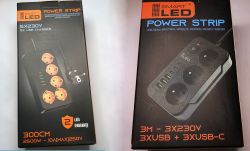Initial XR809 port seems to be working - but only HTTP server works so far.
IMPORTANT: XR809 is using the same codebase/app repo as BK7231T version, which will make it easier to maintain in the long term. Basically, we will be supporting two different platforms now.
There is no backend whatsoever, no flash memory storage, no pins settings, etc.
XR809 app setup guide
1. Checkout https://github.com/openshwprojects/OpenXR809 , add missing toolchain (this is XR809 SDK)
2. Checkout https://github.com/openshwprojects/OpenBK7231T_App to OpenXR809/project/oxr_sharedApp/shared/ (this is our shared multiplatform app)
3. Add missing SSID/pass in prv_config.h
4. Run build_oxr_sharedApp.sh
5. Use pheonixMC to burn firmware by UART on XR809
Proof of concept works, now I will be porting each functionality to XR809, step by step.
Anyone with XR809 devices here? @DrTFav ?
Helpful post? Buy me a coffee.
IMPORTANT: XR809 is using the same codebase/app repo as BK7231T version, which will make it easier to maintain in the long term. Basically, we will be supporting two different platforms now.
There is no backend whatsoever, no flash memory storage, no pins settings, etc.
XR809 app setup guide
1. Checkout https://github.com/openshwprojects/OpenXR809 , add missing toolchain (this is XR809 SDK)
2. Checkout https://github.com/openshwprojects/OpenBK7231T_App to OpenXR809/project/oxr_sharedApp/shared/ (this is our shared multiplatform app)
3. Add missing SSID/pass in prv_config.h
4. Run build_oxr_sharedApp.sh
5. Use pheonixMC to burn firmware by UART on XR809
Proof of concept works, now I will be porting each functionality to XR809, step by step.
Anyone with XR809 devices here? @DrTFav ?





![[BK7231T] My HTTP server, configurator, MQTT support from Home Assistant [BK7231T] My HTTP server, configurator, MQTT support from Home Assistant](https://obrazki.elektroda.pl/3566535000_1644766547_thumb.jpg)
![[BK7231T] My HTTP server, configurator, MQTT support from Home Assistant [BK7231T] My HTTP server, configurator, MQTT support from Home Assistant](https://obrazki.elektroda.pl/1516681200_1644773121_thumb.jpg)
![[BK7231T] My HTTP server, configurator, MQTT support from Home Assistant [BK7231T] My HTTP server, configurator, MQTT support from Home Assistant](https://obrazki.elektroda.pl/1435874900_1644777443_thumb.jpg)
![[BK7231T] My HTTP server, configurator, MQTT support from Home Assistant [BK7231T] My HTTP server, configurator, MQTT support from Home Assistant](https://obrazki.elektroda.pl/4691375500_1644794617_thumb.jpg)
![[BK7231T] My HTTP server, configurator, MQTT support from Home Assistant [BK7231T] My HTTP server, configurator, MQTT support from Home Assistant](https://obrazki.elektroda.pl/6456924300_1644866587_thumb.jpg)
![[BK7231T] My HTTP server, configurator, MQTT support from Home Assistant [BK7231T] My HTTP server, configurator, MQTT support from Home Assistant](https://obrazki.elektroda.pl/5996999600_1644890148_thumb.jpg)